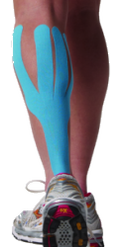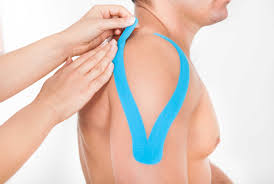The Kinesio Taping Method is a rehabilitative taping technique that is designed to facilitate the body’s natural healing process while providing support and stability to muscles and joints without restricting the body’s range of motion as well as providing extended soft tissue manipulation to prolong the benefits of manual therapy administered within the clinical setting. |
By targeting different receptors within the somatosensory system, Kinesio Tape alleviates pain and facilitates lymphatic drainage by microscopically lifting the skin. This lifting affect forms convolutions in the skin thus increasing interstitial space and allowing for a decrease in inflammation of the affected areas.
Based upon years of clinical use, Kinesio Tape is specifically applied based upon thorough evaluation. The findings of the clinical evaluation or assessment With the utilization of single “I” strips or modifications in the shape of an “X”, “Y” or other specialized shapes as well as the direction and amount of stretch placed on the tape at time of application, Kinesio Tape can be applied in hundreds of ways and has the ability to re-educate the neuromuscular system, reduce pain and inflammation, enhance performance, prevent injury and promote good circulation and healing, and assist in returning the body to homeostasis. |

The Kinesio Benefit
Evaluation and assessment are key in the treatment of any clinical condition. In order to get the desired results from a Kinesio Tape application as well as any other treatment, a full assessment is necessary.
In some cases, the treatment of a condition may require treatment of other underlying conditions as well. This assessment should include manual muscle testing, range of motion testing, gait assessment, and any other orthopedic special tests that is deemed necessary.
The information gained from these assessments will allow for the proper treatment protocol to be laid out. It has been proven to have positive physiological effects on the skin, lymphatic and circulatory system, fascia, muscles, ligaments, tendons, and joints. It can be used in conjunction with a multitude of other treatments and modalities and is effective during the rehabilitative and chronic phases on an injury as well as being used for preventative measures.

 dictate the specifics of the Kinesio Tape application and other possible treatments or modalities.
dictate the specifics of the Kinesio Tape application and other possible treatments or modalities.

